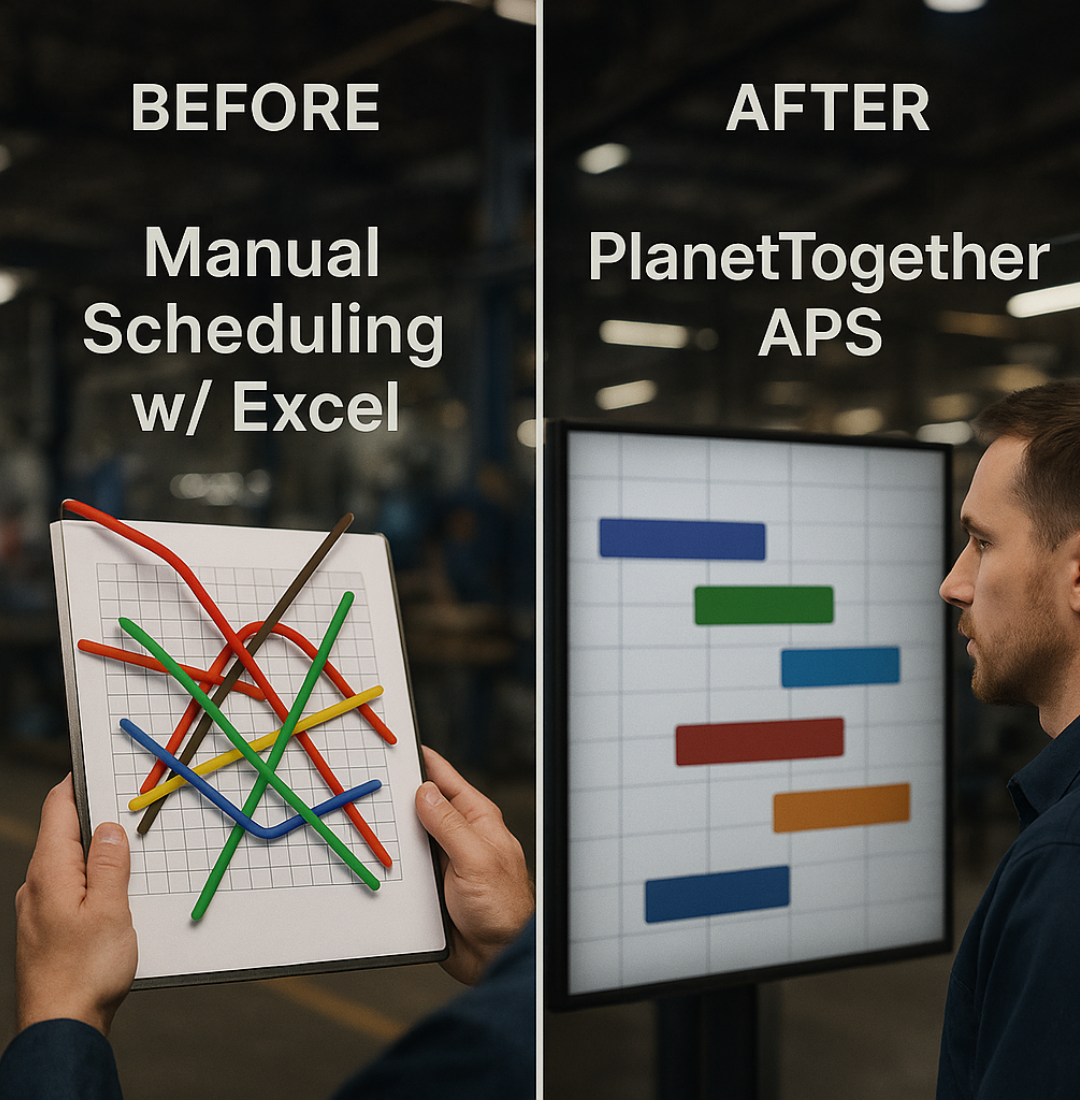Excel has long been the default tool for production scheduling. It is powerful, flexible, and familiar. But as complexity grows in manufacturing environments, spreadsheets start to create more problems than they solve. The truth is that Excel does not scale well for advanced planning and scheduling.
Excel: A Great Tool, with Critical Gaps
Excel gives you a snapshot of your production plan, but it cannot provide a live feed of what is actually happening on the shop floor. The moment you send that spreadsheet to your team, it quickly becomes outdated. If a machine goes down, an order changes, or a supplier misses a shipment, your “master schedule” is already out of sync with reality. We commonly hear from Directors and VPs across all industries that this is where the fire drills begin, with late-night calls, production teams scrambling, and customers frustrated.
Manual updates create another layer of risk. Every formula, every linked tab, and every adjustment introduces the chance of error. One wrong keystroke can throw off capacity, lead times, or material availability. Excel was not designed for multi-variable production scheduling. It is like trying to manage air traffic with sticky notes: it is technically possible, but unnecessarily nerve-racking.
Collaboration is another limitation. Scheduling touches operations, supply chain, customer service, and finance, yet Excel remains siloed by design. Even in cloud versions, it was never built for multi-user collaboration. Misalignment spreads quickly, and confidence in the schedule disappears.
Bottlenecks are also hidden from view. Excel can tally hours or labor, but it does not surface capacity constraints across machines, materials, and people. By the time bottlenecks are visible, they have already caused disruption.
Perhaps the most significant shortcoming is optimization. Excel cannot evaluate competing factors like labor availability, machine constraints, and raw material readiness all at once. That means schedulers are stuck reacting to issues instead of optimizing proactively across the full production system.
As Hector Rivera of GCM Business Consulting and Technology shared during the webinar,
“Excel is not enough when a company is growing fast. Plants spend hours scheduling, but much more time rescheduling, trying to update changes”.

What an APS Platform Brings to the Table
An Advanced Planning and Scheduling (APS) platform solves these challenges by providing real-time visibility, optimization, and decision support. With an APS platform, live data flows directly into the production schedule. If an order changes, a machine goes down, or material is delayed, the schedule adjusts automatically. For the master scheduler, this means no more chasing updates or relying on stale data.
Scenario planning becomes simple. Want to test the impact of adding overtime, inserting a rush order, or delaying a material delivery? An APS platform can run what-if simulations instantly, showing the downstream effects across jobs and resources.
Optimization is also a core strength. An APS platform balances materials, machines, and labor simultaneously to generate the most efficient plan possible. The result is higher throughput, reduced overtime, and more reliable delivery.
For cross-functional teams, PlanetTogether APS offers web analytics and reporting. This allows sales, operations, and finance leaders to view the production data relevant to their role without needing to be schedulers themselves. Each team can see the metrics that matter to them, while the master schedule remains under the control of planning.
As Hector noted,
“With an APS platform like PlanetTogether, companies can reduce rescheduling time by more than 50 percent, freeing planners to focus on improvement instead of firefighting”.
What We Are Seeing in the Market
Across industries and geographies, the same story plays out. Companies stay in Excel scheduling longer than they should because it feels inexpensive. But the hidden costs add up quickly in the form of overtime, expedited freight, missed deliveries, and lost customer trust.
Another hesitation is fear of implementation. Leaders worry about the time and effort to adopt a new scheduling platform. Yet modern APS software integrates with ERP systems and can often be piloted quickly in a single plant before broader rollout.
Finally, there is the misconception that advanced planning and scheduling is only for global enterprises. In reality, mid-sized manufacturers are some of the biggest beneficiaries. By using APS for capacity planning, constraint-based scheduling, and bottleneck management, even single-plant operations can unlock meaningful ROI within months.
The shift away from Excel is no longer just a best practice, it is becoming a competitive necessity. Companies that adopt APS platforms are gaining the agility to adapt to demand volatility, supply disruptions, and labor shortages, while those who stay in spreadsheets fall behind.

How to Start Moving Beyond Excel
If your scheduling process still lives in spreadsheets, the good news is that you can start small.
-
Assess Your Current Scheduling Process: Identify where fire drills happen most often, whether that is machine downtime, material shortages, or order changes.
-
Run a Readiness Check: Measure whether your team, data, and systems are prepared for APS. We offer an APS Readiness Score that helps benchmark your current state.
-
Pilot with a High-Impact Area: Many directors start by applying an APS platform to one plant before expanding further.
-
Build the Business Case: Track the hidden costs of Excel and compare them against the potential savings of advanced planning and scheduling software.
Next Steps for Your Team
Excel will always have a place in business operations, but it was never meant to be the backbone of modern production scheduling. An APS platform gives manufacturers the visibility, optimization, and resilience they need to compete in today’s volatile markets.
If you would like to see where your organization stands, try our APS Readiness Score. And if you missed the live discussion, you can watch the full webinar recording here or by clicking the image below 👇.
